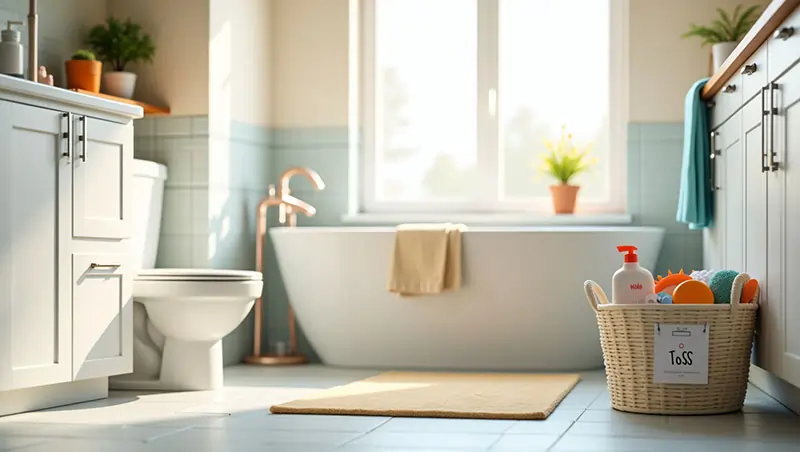A Safer Bathroom Checklist for Kids: What to Keep and What to Toss
Ensuring our children’s safety comes first daily for us as parents, yet the bathroom is sometimes neglected. There are major hazards from wet surfaces, sharp objects, and cleaning chemicals. One should act proactively to avoid mishaps.
Do you know the risks hiding behind those commonplace bathroom products we use daily? For young children, the bathroom can pose risks including:
- Slippery floors,
- Sharp tools,
- Toxic ingredients in common products.
Why Is It Important to Understand Bathroom Safety for Kids?
Young children explore their surroundings and are naturally curious; they often touch and taste objects they come upon. This is especially true in the bathroom, where bright packaging and shiny bottles might be used for toys or candy.
Many bathroom products include endocrine disruptors, among other hidden chemicals. Children’s developing systems and lower body weight make them especially sensitive.
Making a kid’s bathroom safer calls for either keeping or throwing away several objects. We have compiled here a list of handy bathroom basics.
Organize your children’s bathroom with the basics below. Keep the health of your children free from germs and let them grow up surrounded with safer objects to use.
Safer Bathroom Checklist: What to Keep and What to Toss
Particularly if you have young children living with you, let’s review the main things you should keep or eliminate from your bathroom.
1. Toilet Paper
- What to Keep: PFAS-free toilet paper
- What to Toss: Traditional toilet paper that has been treated with chemicals.
Many toilet paper brands are treated with PFAS, or “forever chemicals,” which can disrupt hormones, suppress the immune system, and affect child development. For a safer and more sustainable option, switch to PFAS-free toilet paper. Avoid scented varieties containing undisclosed phthalates or synthetic fragrances. A good-quality brand of toilet paper can prevent allergies or skin irritation, especially for sensitive skin.
2. BPA-Free Bath Toys
- What to Keep: Mold-resistant, BPA-free toys
- What to Toss: Toys that squeak with openings and toys made from foam.
Although bath toys can be entertaining for children, especially those with hidden crevices, they could also contain mold and bacteria. Throw away squirt toys that trap water and choose simpler, BPA-free silicone models that resist mold. After every use, rinse and dry the toys to keep them safe; additionally, give them a weekly vinegar soak for sanitation.
3. Body Wash or Shampoo
- What to Keep: Fragrance-free, EWG-certified products
- What to Toss: Items that contain sulfates, parabens, or artificial fragrances.
Check your child’s shampoo and body wash labels. If they contain;
- Sodium lauryl sulfate,
- Parabens,
- Formaldehyde-releasing preservatives, or
- Fragrance, consider discarding them.
These compounds may have long-term health consequences and aggravate eyes and skin. Select naturally scented or fragrance-free items. Select those tested dermatologically for children or certified by the Environmental Working Group (EWG).
4. Kid-Friendly Toothpaste
- What to Keep: Fluoride-free (for kids), non-toxic varieties
- What to Toss: Toothpaste for adults or products containing synthetic coloring agents.
Though it should be avoided in toothpaste for children under three, fluorine can help prevent cavities. Still, do not use it unless a dentist writes a prescription since many people swallow toothpaste. Fluorosis brought on by too much fluoride can discolor teeth. Choose toothpaste free of fluoride using natural xylitol components.
5. Non-Toxic Cleaning Products
- What to Keep: Plant-based, non-toxic cleaners
- What to Toss: Bleach and ammonia-based disinfectants
Particularly with children around, bathrooms should be kept spotless. Still, conventional cleaners sometimes feature strong chemicals. These compounds, though, can aggravate kids’ lungs, eyes, and skin. Use DIY cleaners including vinegar, baking soda, and essential oils or plant-based products. Store cleaning products in a high cabinet, out of reach for children always.
6. Natural Air Fresheners
- What to Keep: Natural essential oil diffusers
- What to Toss: Sprays, plug-ins, and scented candles
Harmful chemicals including formaldehyde, VOCs, and phthalates abound in artificial air fresheners. These could compromise indoor air quality and aggravate children’s respiratory problems. For natural odor control, then, think about using houseplants and baking soda. Additionally use a diffuser filled with child-safe essential oils such as lavender or chamomile.
7. Soft-to-Touch Towels or Washcloths
- What to Keep: Organic cotton or bamboo fabrics
- What to Toss: Worn-out or synthetic fabrics
Children’s sensitive skin calls for soft, airy towels made of bamboo or organic cotton. Steer clear of polyester mixes and possibly contaminated old towels. Wash towels often using a non-toxic, dye-free detergent.
8. Medicine Box or Cabinet
- What to Keep: Locked away and organized
- What to Toss: Adult products or expired medications
Keep the medicine cabinet locked and out of reach for youngsters. Look for expired goods often, especially vitamins and medications. Separately store children’s medications, and always keep items in their original packaging.
9. Rugs or Simple Flooring
- What to Keep: Non-slip bath mats made from natural rubber
- What to Toss: PVC or vinyl mats with chemical odors
Children often have bathroom mishaps including slips. Use naturally rubber or organic cotton non-slip bath mats. Steer clear of synthetic choices including dangerous chemicals like phthalates or PVC. Select washable mats to help stop mildew and mold growth.
Conclusion
Just some awareness and wise decisions will help your bathroom become a safer place for children without a complete makeover. Knowing what to keep and what to throw helps you teach your kids the value of safe living and shield them from regular dangers. Always read labels; keep educated; and think about buying safety-first products.



![With Halloween Personalized Storybooks from My Story Tale Celebrate your little one’s very first Halloween with [Your Child's] First Halloween, a heart-warming personalized My Story Tale storybook that turns spooky night-time adventures into treasured family memories. Packed with gentle thrills, playful rhymes, and adorable illustrations, this keepsake follows your child on a trick-or-treat journey as they meet friendly cats, witches, skeletons, and spiders along the way, with everything brought to life through fun clues and giggle-worthy surprises. Perfect for bedtime reading or gifting, this book captures the magic of curiosity, courage, and love, making it an unforgettable way to mark a child’s first Halloween night. Or take your kiddo on their very own Halloween Adventure as you and your child step into the magic of Halloween night with a heart-warming personalized story and a spook-tacular adventure to help a friendly ghost find its BOO. Packed with enchanting illustrations, playful rhymes, and just the right touch of spooky fun, this story captures the excitement and the joy of helping others. It’s a keepsake storybook your child will treasure year after year — making memories sweeter than candy. My Story Tale storybooks are completely personalized and let you add names, skin tones, hair color, and includes a special dedication page for a keepsake memory. Each custom book feels like it was made just for your child. Because it was! Celebrate lots of those very special family occasions all year round and put your child at the center of the action. It’s a role they were born to play! First Birthday, First Christmas, Mother’s Day, Father’s Day, and tons of magical adventures in between, you and your child will create a special connection that doesn’t exist on screens or devices. Our vision is bold and clear: to raise a generation of confident readers who know that their story matters. Through our stories, we want children to feel empowered, to see themselves as heroes of their own adventures, and to recognize that their voices and experiences are significant. Every My Story Tale book is made with love using high-quality materials and is printed using the latest digital technology and 100% recycled paper. Hard cover or soft cover available. About My Story Tale At My Story Tale, we believe that every child deserves to feel valued, celebrated, and seen—especially in the stories they read. Our mission is to inspire kids to read more by creating personalized books that celebrate their unique identity. By placing children at the center of every story, we aim to ignite their imagination, build their confidence, and nurture a lifelong love of reading.](https://www.kidsworldfun.com/blog/wp-content/uploads/2025/09/halloween-for-kids.webp)